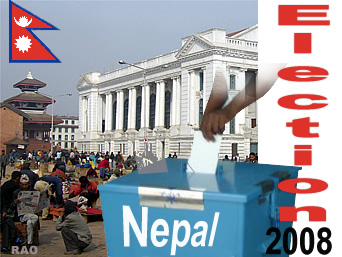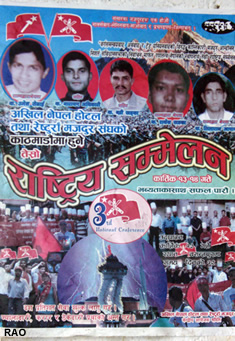|
Nepal
2008: Facts on the Conflict
|
|
Nepal's
Election: A Peaceful Revolution? |
| The Uncertain Future of the New Republic |
 |
Kathmandu/Brussels,
3 July 2008
 |
| Nepal's
major parties should cooperate in a coalition government led by the Maoists,
who won the April Constituent Assembly (CA) elections (see
also Constituent Assembly (CA) elections)
,
to help the world's newest republic avoid political instability.
The
International Crisis Group today released companion reports: Nepal's Election:
A Peaceful Revolution?, an extensive analysis of the 10 April vote, and
Nepal's New Political Landscape, which examines the major challenges remaining
in a peace process that has made considerable progress but is still incomplete. |
|
The
voters in the CA elections (see also Constituent
Assembly (CA) elections) delivered
a mandate for peace and change, giving the Maoists a clear victory but
leaving them without an absolute majority. The major established parties,
shocked by their defeat, have stalled the formation of a Maoist-led coalition
government.
"The
political landscape has changed irrevocably, but the old parties have not
woken up to the new realities", says Rhoderick Chalmers, Crisis Group's
South Asia Deputy Project Director. "The aftermath of the election has
been marred by the behaviour of powerful losers, who are reluctant to keep
the promise of working on the basis of consensus".
Nepal's
Maoists crowned their transition from underground insurgency to open politics
with an electoral victory that was impressive but insufficient to allow
them to dominate the CA, which must both draft a new constitution and serve
as a legislature. Overall, the elections were credible, and the CA is far
more representative than any past parliament. But the Maoist's surprise
success has thrown the traditionally dominant parties into confusion, as
has the emergence of powerful new regional parties.
Multiple
issues need to be tackled in order to build a sustainable peace, most critically
security sector reform. The continuing existence of both the People's Liberation
Army and the Nepal Army is inherently destabilising. The national army
remains outside meaningful democratic control, and Maoist willingness to
discuss compromise options has met with a brick wall.
All
main parties must accept the election results and form a consensus-based
government under a Maoist leadership that in turn still has a distance
to go to prove that it is irrevocably committed to democratic behaviour.
The CA and the new government must also rebuild law and order in the countryside,
put an end to the culture of impunity that grew during the long civil war,
do more to build peace at the local level and adjust to other changes in
the political landscape such as the rise of identity politics.
"The
way in which political leaders cope with the political challenges of the
election aftermath will determine whether the remarkable result delivers
peace and change or further conflict", says Robert Templer, Crisis Group's
Asia Program Director.
| Asia
Report N°155: Nepal's Election: A Peaceful Revolution? |
EXECUTIVE
SUMMARY
Nepal's
constituent assembly (CA) elections (see also
Constituent
Assembly (CA) elections)
marked a
major step forward in the peace process, paving the way for the declaration
of a federal democratic republic and the start of the constitution-writing
process. Although falling short of an outright majority, the Maoists won
a decisive victory at the 10 April 2008 polls, securing a mandate for peace
and change. However, the largely peaceful and well-managed vote opened
a messy new round of political haggling and obstruction. The Maoists have
been unable to secure agreement on a new coalition government. Other parties,
still struggling to accept their defeat, have set new conditions for supporting
a Maoist-led administration.
The
elections delivered a clear and, to many, surprising result. The Communist
Party of Nepal (Maoist, CPN(M)), emerged as the largest party by a wide
margin, winning more than one-third of CA seats. The largest established
parties, the Nepali Congress (NC) and Communist Party of Nepal (Unified
Marxist-Leninist, UML), were not wiped out but have had difficulty coping
with their relatively weak showing - their combined seats are less than
those of the Maoists. The NC was particularly hard hit by the strong performance
of new Madhesi parties, among which the Madhesi Janadhikar Forum (MJF)
(see
also Madhesi)
has
secured a dominant position. Royalist parties failed to win a single first-past-the-post
(FPTP) seat, only saving a toehold in the new assembly through the parallel
proportional representation (PR) contest.
Party
campaigning built the atmosphere for a lively and passionate contest. Long-suffering
and politically sophisticated voters proved a testing audience, keen to
hear what candidates had to say for themselves but well prepared to exercise
their own judgement. It was not the cleanest of campaigns. The established
parties resorted to old tricks to steal a march on their opponents. The
Maoists, and to a lesser extent the MJF (see
also Madhesi) ,
distinguished themselves primarily by outdoing their more experienced rivals
at their own game. The CPN(M) did use intimidation and coercion but also
exercised great restraint in the face of the possibly calculated killing
of fifteen of its activists. At the same time it demonstrated formidable
organisation and motivation - qualities which were deservedly reflected
in its victory.
The
vote itself and the complex parallel count went remarkably smoothly, with
complete results (including repolling) ready within fifteen days. Still,
final results, including the approved lists of parties' selections to fill
PR seats, were published only on 8 May, almost a month after the election.
Five by-elections, for seats resigned by individuals who won FPTP contests
from two constituencies, will probably be held only in September. One declared
FPTP result has been suspended by court order following an appeal by the
(narrow) loser. The 26 individuals nominated by the cabinet, who will complete
the complement of 601 CA members, have yet to be decided thanks to the
elusiveness of the required inter-party "consensus".
Whatever
the broad political breakdown, the CA is a remarkably inclusive body, far
more representative of Nepal's caste, ethnic, religious and regional diversity
than any past parliament. One third of its members are women, catapulting
the country into regional leadership on gender representation. Thanks largely
to the PR component, no fewer than 25 parties have secured CA seats, reflecting
a kaleidoscope of ideological and regional or community-specific agendas.
The MJF proved that it was more than just a brand name for a vague sense
of Madhesi grievance but a viable political machine able to mobilise votes
and put identity politics on the map - probably for the foreseeable future.
The
Maoist victory was not unsullied. The CPN(M) engaged in orchestrated strong-arm
tactics, generally facing down other parties, which embraced similar means.
Some resounding constituency results would have embarrassed the more modest
political bosses who engineer realistic-looking margins of victory. Nevertheless,
its strong showing was not manufactured. Voters were willing to give credit
for its struggle and sacrifice, recognising that the Maoists were the architects
of the federal republican agenda. They struck a chord with popular aspirations
that the old parties had not even woken up to. In this, as in their more
dubious techniques, they made full use of the fact that they had stayed
in close touch with ordinary people and not lost their heads in Kathmandu
politicking. Meanwhile, their convincing victories in many urban constituencies
- the CPN(M) emerged the clear winner in the greater Kathmandu area - demonstrated
that they did not profit solely by preying on vulnerable rural voters beyond
the eyes of observers.
All
in all, the elections were credible and a credit to those who organised,
fought and voted in them. Although some disruption and intimidation took
place, it was far less than predicted. Voters were offered a genuine political
debate and real choices. In return, they took their responsibilities seriously
and turned out in large numbers to have their say. For all the losers'
public petulance, very few collected evidence to file formal complaints.
What remains is for the political elite to digest the message that Nepal's
citizens have at last been allowed to send them.
This
report describes the campaign and vote, assesses the credibility of the
election and analyses the results. A companion policy report published
simultaneously surveys the new political landscape and examines the remaining
transitional challenges. The CA has to deliver a functioning government,
act as a legislature and also write a new constitution. Each of these would
be a tough task in its own right; managing all simultaneously while seeing
the peace process through to a stable conclusion will require further commitment
and patience.
| Source:
International Crisis Group 2008 |
 |
 |
 |
External
links |
top
| Madhesi
factbox |
 |
 |
 |
 Nepal's largest
ethnic group; make up about one third of Nepal's 27 million people Nepal's largest
ethnic group; make up about one third of Nepal's 27 million people
 Concentrated
in the lowland Terai region, southern Nepal, the country's industrial and
agricultural heartland Concentrated
in the lowland Terai region, southern Nepal, the country's industrial and
agricultural heartland
 Traditionally,
their main ethnic rivals are the politically dominant hill people known
as Pahades Traditionally,
their main ethnic rivals are the politically dominant hill people known
as Pahades
 Comprised
of various sub-groups with several different languages and dialects and
have only recently developed a political consciousness and unity of purpose Comprised
of various sub-groups with several different languages and dialects and
have only recently developed a political consciousness and unity of purpose
 Campaign
for regional autonomy for the Terai, a federal Nepal, and greater representation
in parliament Campaign
for regional autonomy for the Terai, a federal Nepal, and greater representation
in parliament
 Militant
factions such as the Madhesi People's Rights Forum (MPRF) and the Janatantrik
Terai Mukti Morcha (JTMM) have carried out violent acts Militant
factions such as the Madhesi People's Rights Forum (MPRF) and the Janatantrik
Terai Mukti Morcha (JTMM) have carried out violent acts
 Not
allied in any way to the Maoists who have separate political goals Not
allied in any way to the Maoists who have separate political goals
 Include
some of the most impoverished and disadvantaged castes in Nepal such as
Badis (traditional sex workers) and Kamaiyas (bonded labourers) Include
some of the most impoverished and disadvantaged castes in Nepal such as
Badis (traditional sex workers) and Kamaiyas (bonded labourers)
According
to rights activists, Maoist leaders are unable to control their supporters. |
|
top
|
More
Information
|
 |

|
 |
|
Nepal
|
|





